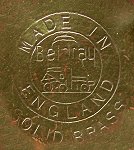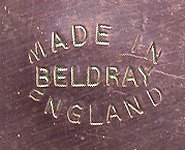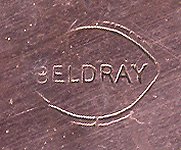 |
Bradley & Co. Ltd
(Beldray)
Mount Pleasant, Bilston |
 |
3. Art Metalware
 |
Fruit bowl in brass, with acanthus band.
photo courtesy of Vin Callcut.
Other photos on this page by Jaap Arriens and Frank Sharman.
|
A report on the founder of the company, Walter S.
Bradley, which appeared in the Birmingham Gazette on 16th
September 1908, suggests that the firm started making art metalware in
or about 1903. This would be quite a late date to enter this
field, many of the other makers in the Wolverhampton area having started
around the 1870s. But it seems to be a firm date.
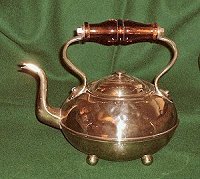 |
However the earliest known company catalogue of
holloware lists no les than nine different copper kettles,
mostly of a plain design. The catalogue also adverts
to a separate art metalware catalogue, suggesting that the
plain copper kettles, at least, were seen as part of their
normal stock and also suggesting that the company made
copper kettles long before 1903. |
| Such documents on the history of Beldray as there are
give no specific reason given for the company entering into
this field. The art metalwares were introduced about
the time that the founder's eldest son, Hermon Bradley,
joined the firm and it was originally thought that the
introduction of the new line may have been something to do
with him. But it is now clear that the most important
factor was Harry Doubleday's joining the firm in 1902 or
thereabouts as the works manager. |
| He had previously
worked with Sankey's, in production, and was engaged by
Walter Bradley specifically to modernise the factory and to
help lead expansion. Doubleday would have been well
acquainted with Sankey's successful brass and copperwares
and well aware that, for a company which had been working in
sheet metal for many years, there would be little or no
technical problem in adopting new materials and that the new
machinery he was installing could be used for the purpose. |
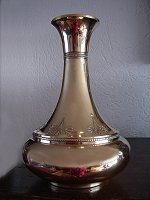 |
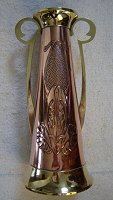 |
The art metalware products were made of brass or copper,
with the occasional use of wrought iron for stands and such.
The wrought iron parts were probably made by Bradley's
themselves as there is clear evidence of blacksmithing on
their premises. Copper was also used as a substrate
for other finishes, such as a bronzed finish and later,
after the introduction of chrome plating to the UK in 1925,
for chrome plate. Before that a silvery finish had
been obtained by the use of a chemical applied in the same
way as the bronze finish. Brassware was also
finished in a matt gold. Many of the variations of
design shown in the catalogues and surviving pieces were
obtained by making different combinations of finishes and
body shapes and decorative bands. |
| Whilst the company made almost everything in the art
metalware line there are far fewer trays than one might
expect. This may be because trays were an established
speciality of Joseph Sankey & Sons who were just down the
road. But there is a much greater variety of vases and
bowls than Sankeys, or any of the Wolverhampton makers,
produced. Those features of the range, and the
presence of many smokers stands, rather suggests that
Beldray would have had a large market supplying hotels,
restaurants, clubs and pubs. Those types of users
continued to use brassware long after it and copperware had
become very much less fashionable with the passing of the
Arts and Crafts style. At what might be seen as the
other end of the social and moral spectrum, many of their
brass vases have been seen on altars and in other parts of
churches. |
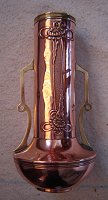 |
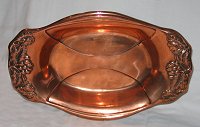 |
It is also of interest that the company's earlier
catalogues refer to "art metalware" but the later ones refer
to "metalware in brass and copper" as if the phrase "art
metalware" had become unfashionable. |
| It is known, from the testimony of those who worked
there, that the company's own drafting office designed
everything on the "copper side" in the 1930s and this was
almost certainly the practice from the start. (It may
be relevant that the Bilston Art and Technical College was
just a hundred yards down Mount Pleasant from the Beldray
works). The company's art metalware designs seem to
have followed design fashions closely, from the Japanese
influenced designs at the beginning of production, to the
Art Deco influenced designs at the end of production.
Design was almost certainly driven by ideas of what would
sell and there is little or no evidence of any attempt to
lead fashion or to produce innovative designs. |
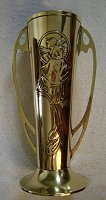 |
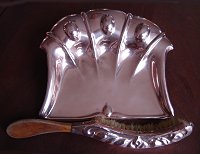 |
Production of art metalware ended in 1939. The
testimony of those working there at the time is to the
effect that less and less was being produced in the late
1930s and that production cased altogether at the outbreak
of war. |
| Mary Southall says: "1939/45 saw [Bradleys] involved with
munitions once more; alas this meant the end of the Art Metal section.
The area where all this lovely stuff was produced was called the 'Copperside'.
Soon this place was used for manufacturing bomb tails, parachute
containers, smoke bombs, etc., etc.. It was still called the 'Copperside'
by the older people of the factory until it was demolished in 1980". |
 |
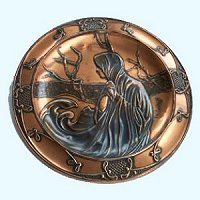 |
Apparently the drafting office did engage in
producing new designs for a proposed post-war
re-introduction of the line but this never happened.
|
| All of the art metalware seems to have been sold through
the trade. The known catalogues are all directed at
the trade and no flyers or advertisements have been found
which indicate any form of direct selling to the public.
To the right is the front page of a catalogue, undated but
apparently from the 1930s, which shows a vase, a smoker's
stand, a cache pot, a rose bowl and a fruit bowl, with a
glass dish. Bradley's did not make glass and the
glassware for the many items which called for them were
undoubtedly bought in, but where from is not known. |
 |
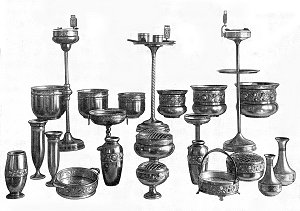 |
A number of flyers (apparently from the 1930s) advertise
"cases" containing a mixed range of items which retailers
could buy as a lot. This picture shows the contents of
Case No.6, showing a representative range of items. |
| The factory is known to have had a blacksmith's shop at
one point in its history and the wrought iron elements of
this shop would have been made there. (The copper
trays were also sold separately as "waiters"). The
company also made copper kettles on stands, some of which
were of wrought iron (whilst others were of cast brass).
Any use of cast iron seems to have ceased by the 1930s. |
 |
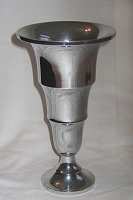 |
Chrome plating was not introduced into industrial
production until
1925, when it soon became fashionable. Bradley's seem
to have taken it up early, as a replacement for their
"oxidised silver" finish. Some of their existing
designs in copper were produced in chrome versions, copper
being a good substrate for chrome plating. But they also
designed items for the finish, with more than a nod to the
art deco style which became fashionable at the same time. |
| The company's range included the basic items which all
makers of art metalware went in for, including water jugs or
ewers. This diamond pattern seems to be exclusive to
Beldray. The do not seem to have made much use of the
"beaten" finish popular with other makers, it seeming that
it was only used for a copper water can. |
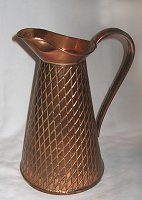 |
Four forms of the company' mark are known on their art metalware.
Three of them are shown here.
The circle with the bell and the dray must be, it is suggested
elsewhere on these pages, after 1918. The other two may both be
earlier but seem to have continued in use in parallel with the bell and
dray. The fourth form, rarely met, is the name Beldray in lower
case letters which are stretched vertically.
 |
Beldray art metalware continues to be of
practical as well as decorative use today. |
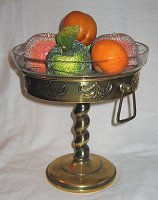 |
|








